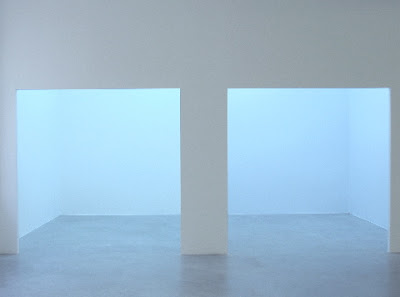Spencer Finch
Thursday, 16 April 2009
Work from Prussian Blue and others. Finch’s work is a great conceptual examination of light and color, and I have only posted a small sampling of it here.
Descriptions (in order):
Sky (Over Coney Island, November 26th, 2004, 12:47pm. Southwest view over the Cyclone.) | 2004, balloons, helium and string. Installation at Miami Beach. Violet balloons inflated inside cobalt balloons to precisely match the color of the sky over Coney Island.
Two Examples of Molecular Orbital Theory (Prussian Blue) | 2005, Fluorescent lights, filters, acrylic paint. This installation presents two physical theories of color. The left room creates Prussian blue with filtered light and white walls, the right room creates Prussian blue with white light and painted walls.
West (Sunset in My Motel Room, Monument Valley, January 26, 2007, 5:36-6:06 PM)) | 2007, 9 channel synchronized video installation with 9 TV monitors. Total running time: 31 minutes 5 seconds
Grand Canyon from Valhalla Point with My Eyes Closed (morning, late morning, noon, evening) | 1995, 21″ x 99″, ink on mutsu paper.
_________________________________
“…Prussian blue, the pigment that was the first artificial pigment, and invented in this very city by Heinrich Diesbach some 300 years ago. Suddenly blue was for the first time available as an affordable colour, both commercially and artistically. Its use quickly spread to textiles and it was notably used to dye the uniforms of the Prussian army. In the 19th century it showed itself useful for the early photographical pioneers and was used for cyanotypes or blueprints.
Prussian Blue, 2005 is a three-dimensional model of the molecular structure of said pigment, executed using standard light bulbs in different sizes. As all Finch’s works, the chandelier is representational. This is in fact what the pigment looks like on the molecular level.
The main work that Finch has made especially for the exhibition is an installation called Two Examples of Molecular Orbital Theory (Prussian Blue) 2005. Blue light is seen coming from two large door openings leading in to large light-filled rooms. Both appear blue, but the colour is achieved by different means. Again the artist questions what we see but also shows faith in representing the unattainable – be it the colour of Jackie’s pillbox hat or the elusive position of electrons in a molecule. Similar ideas come back in a series of water-colours, Study for a Transparent Language, Index of Prussian Blue (35 watercolour drawings), 2005, that catalogues alphabetically 35 different names for the pigment, ranging from American Blue to Williamson’s Blue. But again, does anyone know what blue is?” – Press release from Galerie Nordenhake
Finch has a collection of short reviews here.



